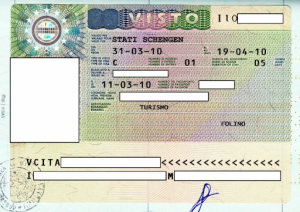Visto (visa)
In addition to a passport, the citizens of non-European countries need a visto (visa) to enter Italy. Find out what a visto is, how many types of visto exist and how to apply for it.
Every person from a non-European country who wants to enter Italy must have a visto (visa). The only exception is for people who enter Italy to apply for international protection.
The visto is the authorisation of the Italian state to legally enter the country. It has the form of a sticker and must be applied to the passport. It will then be checked by officers at the airport or at the border.

Types of visas
There is a specific type of visto for each reason for entering Italy. The most common are:
- Visto per lavoro (read the information on the decreto flussi if you want to come to Italy for work reasons)
- Visto per studio (student visa)
- Visto turistico (tourist visa)
- Visto per cure mediche (medical treatment visa)
- Visto per affari (business visa)
- Visto per motivi familiari (family visa)
And visas can be:
- Per soggiorno di breve durata (short stay)
with a visto per soggiorno di breve durata (called visto Schengen) you can stay in Italy for up to 90 days. This type of visto is mainly for tourists, business trips or cultural visits. The cost of this visto is € 60. - Per soggiorno di lunga durata (long stay)
with a visto per soggiorno di lunga durata (called visto nazionale) you can stay in Italy for more than 90 days. This visto is mainly for work, study or family reasons. A visto per soggiorno di lunga durata costs € 116, with the exception of visto per studenti which costs € 50.
Do you need a visto to enter Italy?
On this website of the Ministry of Foreign Affairs, available in Italian, English, Arabic, Russian and Chinese you can find out:
- If you need a visto
- Which documents you need to apply for the visto
- Its cost
How to apply for a visto
You must apply for a visto at the Italian Embassy or Consulate in your country of origin or residence.
In some countries you must go physically to the Italian embassy or consulate to apply for the visa. In other countries you must apply online through an external private agency that works for the embassy or consulate. Here is the list of countries that manage applications through external agencies and the links to the agencies’ portals.
In general, for all types of visto you must provide the following documents and information:
- completed application form
- passport size photo
- your valid passport
- duration and reason of your stay in Italy (work, health, etc.)
- your outbound and return flight details
- proof that you have the money to support yourself for the duration of your trip and stay
- health insurance with a minimum coverage of € 30,000
- declaration of accommodation (the address of your accommodation in Italy)
You will also be asked to provide specific documents based on the type of visto that you apply for, to confirm your reason for entering Italy. Here is a list of specific documents according to the types of visto.
The visto is issued by the embassy or consulate within 90 days from the date of your application. If the embassy needs clarifications or more documents, it can take longer than 90 days.
Make sure to apply at least three or four months before your departure for Italy.
Useful link
-
Website of the Farnesina with information on the visa for Italy
On this website you can find out if you need a visa to enter Italy and how to get it
Go to the link -
Website of the Ministry of the Foreign Affairs with information on Italia embassies and consulates in the world
On this website you can find out the address and other information on the Italian embassies and consulates in your country.
Go to the link
You might be interested in
-
The decreto flussi
See the article -
International protection
See the article -
The permesso di soggiorno (residence permit)
See the article